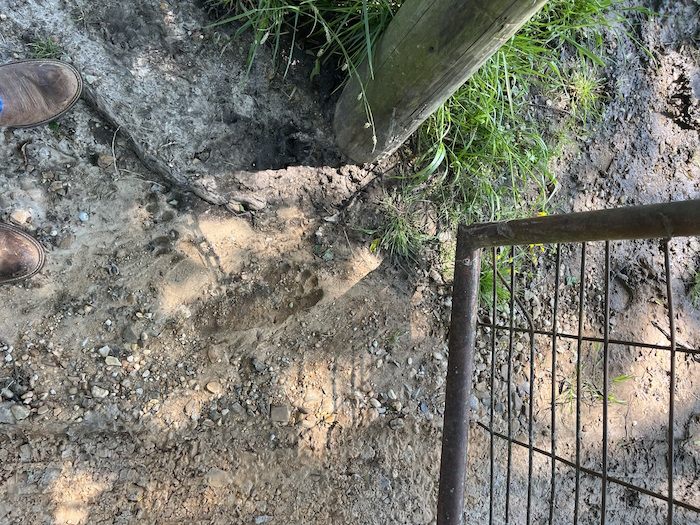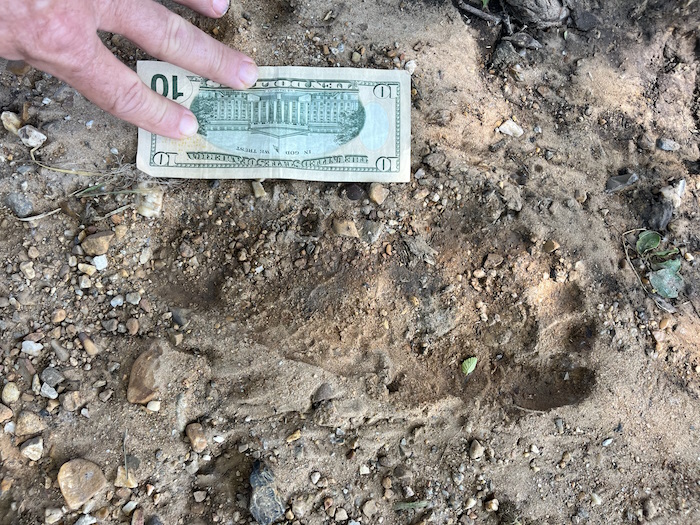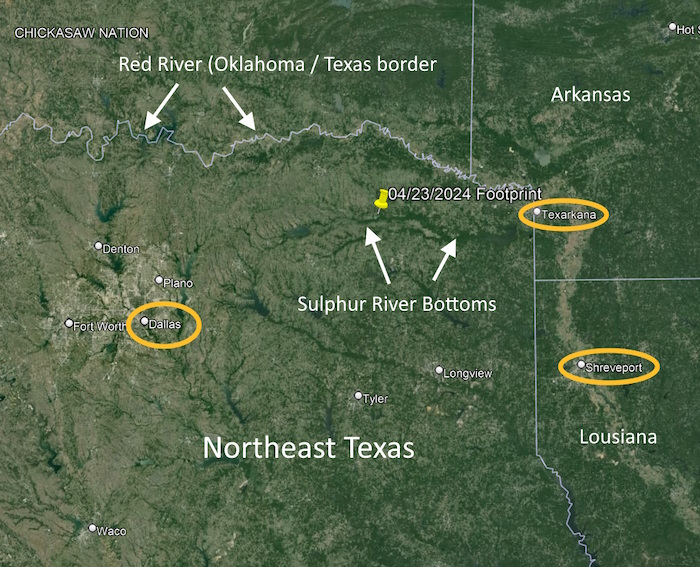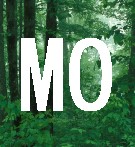Geographical Index > United States > Texas > Red River County > Report # 77205
(Class B)
Submitted by witness Greg Walker on Friday, April 26, 2024.
Apparent bigfoot track (see photos) in Sulphur River bottom outside town of Bogota
(Show Printer-friendly Version)
YEAR: 2024
SEASON: Spring MONTH: April DATE: 23rd STATE: Texas COUNTY: Red River County LOCATION DETAILS: At the end of CR 1482 NEAREST TOWN: Bogata NEAREST ROAD: 271 OBSERVED: I lease some land near the south Sulphur River in far south Red River County. I went to check my cows Tuesday and just inside my gate, I saw a track made by something heavy enough to leave a clear imprint in gravel mixed soil. There is no logical reason someone would be barefoot back there. It is very secluded and only 4-5 people have an easement to drive thru there.
ALSO NOTICED: No OTHER WITNESSES: 0 OTHER STORIES: No TIME AND CONDITIONS: The print I found late afternoon ENVIRONMENT: Sulphur River bottoms
Follow-up investigation report by BFRO Investigator Caroline Curtis:
You can click these photos for larger versions that show better details.


The witness and I discussed these prints and the property. He stated there are only three people that actually walk on this property. The gates are locked. He did look around for more prints, and he looks around each time he is out there, time permitting.
The town of Bogota is surrounded by agricultural country which produces thousands of bales of cotton annually, together with large crops of corn and other feed for cattle.
We are currently accepting applications for the upcoming 2024 Texas Expedition with Organizer Mike Janakes. That will happen from October 17th (Thursday) - October 20th (Sunday) in a different part of the state, further south.
________________________________________________
Investigator Matt Moneymaker notes
Anyone who has been following the bigfoot subject for many years will be familiar with the place name "Sulphur River Bottoms". It is one of the most forbidding swampy zones in America and figures largely in the film "The legend of Boggy Creek". Boggy Creek itself is part of the much, much larger Sulphur River riparian system.

This footprint looks like a bigfoot track to me. As usual we don't like to point out all of the subtleties that separate a fake from a legit track (so as not to educate hoaxers), but I can see several elements of authenticity, and have seen similar bigfoot tracks in person.
However, I wanted a second opinion so I sent the photos to Cliff Barackman. He really knows his stuff when it comes to bigfoot tracks. In short, he also thinks the track was made by a bigfoot.
Cliff pointed out a few things I missed, things that basically elminate the possibility of a human footprint or bear footprint.
We both agreed that it is not a bear track. A few toes are pressed in far enough that claw marks would be visible.
More importantly, a bear cannot articulate its toes independently as much as a human or Bigfoot, and does not have more pronounced “big toe”.
Fun fact: If a footprint shows a big toe (more pronounced than the others) then it is definitely not a bear track.
This footprint indicates a big toe, which is pressed into the soil deeper than the other toes — something a bear cannot do.
Cliff let me know that my scaling estimates for the height based on the foot length were flawed because there is no way to know the actual length of the foot that made the print. Here's why:
Although the footprint may seem whole, though bent as if the figure pivoted while standing there, Cliff made me see what he saw immediately, based on seeing other impressions like this that were cast.
What you see in these photos is not one footprint distorted by the foot pivoting. It is actually two "half tracks" on top of eachother. The foot pressed down then lifted up and pressed down again, but both times only part of the foot made an impression in the gravelly substrate.
On the second press of the foot, some part of the heel landed on a rock protruding from the dirt. That rock appears just below and outside the outline of the "bent" track. If you use the toes and width of the ball of the foot as one line, and you draw a line perpenticular from the center of the ball line, the heel will come down on that smooth protruding rock. The heel would not press into the ground there like up at the front of the foot.
Cliff also pointed out a faint midtarsal ridge in that second press. This is part of the evidence of a non-human foot anatomy -- different from a human's foot. It is the characteristic foot anatomy of a bigfoot. Bigfoots can bend their feet roughly half way from front, a bit like we can bend our hands when we close them to grab something. This adaptation would help them climb steep slopes or climb trees. Dr. Jeff Meldrum has an extensive powerpoint presentation (and journal article) showing many examples of this signature anatomical feature visible in dozens of footprint casts, and hundreds of clear photos of bigfoot tracks.
Human feet, by contrast, are evolved to be able to curl inward only a bit by the ball, but not bend in the middle like your hand. Human feet are adapted for running on flat ground for long distances, rather than for climbing trees or steep slopes.
The indentation created by this flexible foot lifting off the ground is what one would expect for a bigfoot but not for a human. A human foot would only flex right at the ball and not further back from the toes. The track would reflect that. It doesn't. It's not a human track for that reason alone (there are other reasons too).
Cliff and I also talked about the height calculation if, say, the track was actually 10 inches long.
Using the Patterson Creature measurements we can take a stab at a rough height for a bigfoot with 10 inch long feet.
Most of the qualified investigators who have sought to figure out the height of Patty over the years put her height at roughly 6'8" (80") or just under that height. That height figure for Patty is usually derived from the pretty precise measurement of Patty's feet, based on the track impressions in the soft soil she left behind that day. Those were complete tracks. The foot that made them defiintely measured ~14.5 inches long.
Remember those two numbers (14.5 & 80) to calculate a rough ratio for scaling the height of a bigfoot based on track length. The ratio is 5.517. Thus if bigfoot tracks are 10 inches long the height would be roughly 55 inches -- about 4.5 feet tall (a juvenile) -- assuming the foot length vs. height ratios are roughly the same for a male and female bigfoot. The ratios between males and females are probably very similar.
This ratio shows that bigfoot feet are proportionally larger than human feet, compared to their height. They really do have big feet.
My own feet are close to 10 inches long. I stand slightly under 6 feet tall. A guy we know who stands 7'2" tall has feet almost exactly 13 inches long (Cliff measured them to be sure). Consider the ratios. The very tall guy's feet are signficantly shorter than Patty's feet, but he stands significantly taller (6 inches taller) than Patty.
Cliff will pull you deep into the weeds regarding every scientific attempt to calculate Patty's height. The outlier figure for Patty's height was derived from the computerized Glickman study years ago. By his estimates Patty stood roughly 7'2" tall.
Glickman was a computer whiz and mathematician, and one of those skeptics who comes to the mystery thinking Patty was a costume, but eventually realizes she could not have been a costume.
Glickman scaled the height based on a stick that Patty nearly stepped on while walking on her path that day. Rene Dahinden collected that stick when the tracks were first examined over the following days. He knew the stick might be helpful in scaling the height.
The problem was that the stick was not aligned exactly 90 degrees to the view angle of the camera. So meausuring what is seen on the screen to use for scaling does not work well because the stick would have appeared longer on screen if it was fully perpendicular to the camera. It was at an angle though. How much of an angle is not known, so its measurement on screen can not be accurately adjusted.
If the stick appeared shorter because of its angle to the camera, then the calculation would make Patty's height seem taller.
Cliff and I both agreed that this figure must be a juvenile bigfoot because of its relatively small size -- relative to other bigfoot tracks.
The location being in Texas will no doubt make some people jump up to assert that it could be tracks of an illegal migrant. There is a list of factors that make that scenario unlikely. The location is not near the southern border of Texas but rather way up within a few miles of the Oklahoma border. Also, illegal migrants are not running around barefoot, especially not in remote ranch lands near Oklahoma. That idea is absurd.
It appears that a juvenile bigfoot came to this cattle gate and opened it up to step through. There were no missing cows and the guy didn't keep looking around for more tracks because he wasn't sure about this first one. At least he took photos and had the presence of mind to include a scale object next to the footprint -- the $10 bill.
The helpful takeaway from this ramble:
If you find very clear, whole, deep tracks with toes, and thus with lengths that can be accurately measured, you can multiply the length in inches by 5.517 to get a rough height estimate in inches.
Commit this number to memory: 5.517
Cliff has a hotspot in north central Oregon where he often finds and casts fresh tracks. He has also found real bigfoot tracks in other parts of the Pac NW. They usually come in two length spans when there are two individuals, which he assumes indicates a male and female. The smaller range is 13-15 inches for assumed full grown females. For full grown males the range is typcially between 15-17 inches.
There are significant outliers on the top end though. I have personally seen credible track casts that measured twenty inches long. Using our PGF ratio the height of that bigfoot was roughly 9.2 feet tall -- a towering behemoth.
That extreme height range is depicted in several drawings over the years, drawings made at the direction of close range eyewitnesses showing the height of the bigfoot compared to those witnesses. The drawing show bigfoots standing almost twice the height of the adult human witnesses.
About BFRO Investigator Caroline Curtis:
- Worked as an Assistant to a Circuit Court Judge in Florida for thirteen years
- An avid outdoorswoman, growing up in the UP of Michigan on a family-owned fishing and hunting resort
- Certified Visual Tracker, Level 1
- Attended and assisted with numerous public and private BFRO expeditions
- She and the Florida BFRO organized South Florida Expedition 2008, North Florida Expedition 2008 and Central Florida Expedition in 2009.
- She and the Michigan BFRO organized the Lower-Michigan Expedition in 2011, Michigan UP Expeditions in 2012, 2013, 2015, 2016, 2018 and Wisconsin 2018
- BFRO Secretary for almost 20 years
|






















